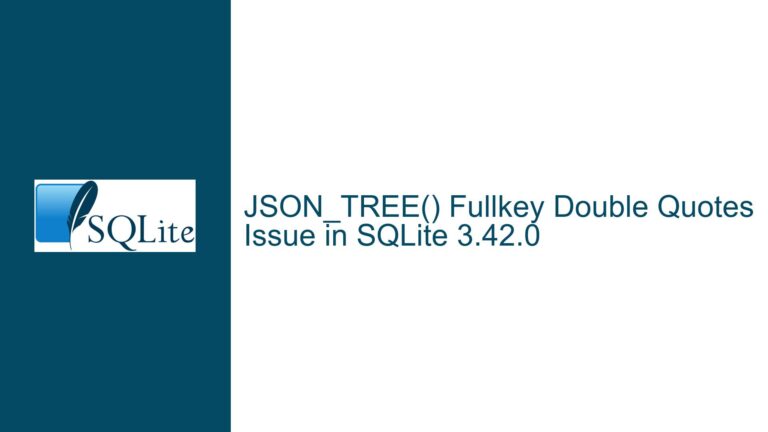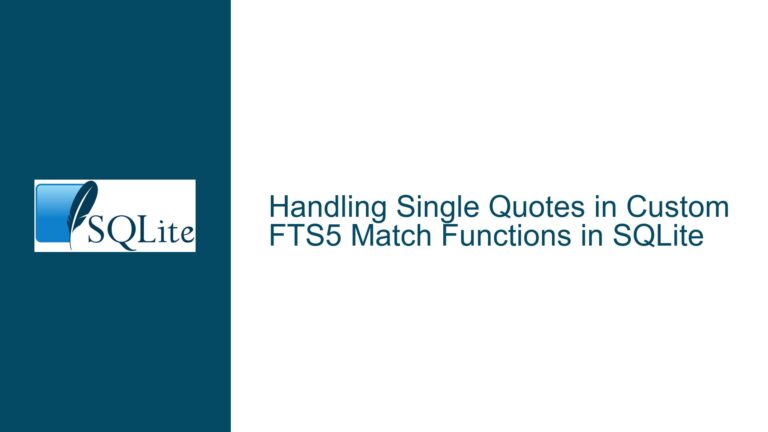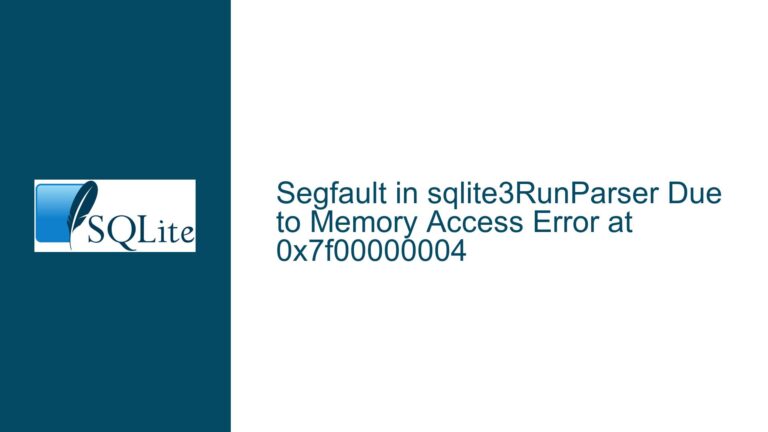Resolving Ambiguous Token Pair Joins and Lemma Filtering in SQLite
Understanding Multi-Table Token Relationships and Alias Conflicts
Issue Overview
The core challenge involves querying a token-pair relationship while resolving token lemmas (text values) instead of numeric IDs. The schema includes two tables:
- tokens: Stores lexical entries with
id,lemma(text representation),pos(part-of-speech tag), andcount(frequency). - pairs: Defines relationships between token IDs via
id1andid2, with a composite unique constraint on these columns.
The user attempted to retrieve all tokens paired with the lemma ‘rock’ using a self-join on the tokens table but encountered syntax and logic errors. The initial working query filtered by a hardcoded id1 value (422) but failed when transitioning to a lemma-based filter. The error arises from:
- Ambiguous table references due to unaliased duplicate joins on
tokens - Incorrect column qualification in the
WHEREclause - Implicit assumptions about table relationships
For example, the invalid query JOIN tokens ON pairs.id1 = tokens.id after already referencing tokens in the FROM clause creates a conflict. SQLite cannot distinguish between the first tokens instance (aliased implicitly as tokens) and the second instance in the join. This violates the requirement for unique table identifiers in multi-table operations.
Structural Misalignments in Joins and Column Referencing
Cause 1: Unaliased Self-Joins
When joining the same table multiple times in a query, SQL requires explicit aliases to disambiguate column references. The original query joins tokens twice without aliases, causing the parser to treat both instances as the same table. This leads to circular logic: the pairs.id1 and pairs.id2 both attempt to reference the same tokens.id column, creating an unresolvable loop.
Cause 2: Implicit Column Context in WHERE Clauses
The invalid WHERE token.lemma = 'rock' clause assumes a table named token exists, but the actual table is tokens. This typographical error masks a deeper issue: even if corrected to tokens.lemma, the ambiguity persists because two tokens instances are present. Column references must explicitly specify which table alias they belong to.
Cause 3: Misinterpretation of Pair Relationships
The pairs table links two token IDs, but the query must resolve both id1 and id2 to their respective lemma texts. The initial approach incorrectly assumes a single tokens join can satisfy both ends of the pair relationship. In reality, each token ID in pairs requires a separate join to tokens with distinct aliases.
Resolving Alias Ambiguity and Rebuilding the Join Logic
Step 1: Assign Explicit Aliases to Repeated Tables
To disambiguate the two tokens references, assign unique aliases during joining:
SELECT t2.*
FROM tokens t1
JOIN pairs p ON t1.id = p.id1
JOIN tokens t2 ON t2.id = p.id2
WHERE t1.lemma = 'rock';
t1represents the token with lemma ‘rock’ (acting asid1in pairs)t2represents tokens paired with ‘rock’ (acting asid2in pairs)- The
pairstable bridgest1.id(source) andt2.id(target)
Step 2: Qualify All Column References
Explicitly prefix columns with their table aliases to avoid ambiguity:
SELECT
t2.id AS paired_token_id,
t2.lemma AS paired_lemma,
t2.pos AS paired_pos,
t2.count AS paired_count
FROM tokens t1
JOIN pairs p ON t1.id = p.id1
JOIN tokens t2 ON t2.id = p.id2
WHERE t1.lemma = 'rock';
This clarifies that t1 is the source token (filtered by lemma), and t2 is the paired token whose details are being retrieved.
Step 3: Validate Pairing Logic with Sample Data
Consider the following dataset:
tokens:
| id | lemma | pos | count |
|---|---|---|---|
| 422 | rock | NOUN | 50 |
| 423 | stone | NOUN | 30 |
| 424 | roll | VERB | 20 |
pairs:
| id | id1 | id2 | count |
|---|---|---|---|
| 1 | 422 | 423 | 12 |
| 2 | 422 | 424 | 8 |
Executing the corrected query returns:
| paired_token_id | paired_lemma | paired_pos | paired_count |
|---|---|---|---|
| 423 | stone | NOUN | 30 |
| 424 | roll | VERB | 20 |
This confirms that all tokens paired with ‘rock’ (id=422) are correctly resolved.
Step 4: Address Edge Cases and Performance
- No Matches: If no pairs exist for ‘rock’, the query returns an empty set. Use
LEFT JOINto include unpaired tokens if necessary. - Case Sensitivity: SQLite’s
WHERE t1.lemma = 'rock'is case-insensitive by default. UseCOLLATE NOCASEfor explicit case handling. - Index Optimization: Ensure indexes exist on
tokens.lemma,pairs.id1, andpairs.id2to speed up joins.
Step 5: Avoiding SELECT * in Join Queries
Using SELECT * in multi-join queries risks column duplication and ambiguity. Explicitly list columns with aliases:
-- Problematic
SELECT *
FROM tokens t1
JOIN pairs p ON t1.id = p.id1
JOIN tokens t2 ON t2.id = p.id2;
-- Resolved
SELECT
t1.id AS source_id,
t1.lemma AS source_lemma,
t2.id AS paired_id,
t2.lemma AS paired_lemma
FROM tokens t1
JOIN pairs p ON t1.id = p.id1
JOIN tokens t2 ON t2.id = p.id2;
This prevents conflicts between t1.id and t2.id in the result set.
Step 6: Extending to Reverse Pair Relationships
To find tokens that pair with ‘rock’ as id2 instead of id1, adjust the join logic:
SELECT t1.*
FROM tokens t1
JOIN pairs p ON t1.id = p.id1
JOIN tokens t2 ON t2.id = p.id2
WHERE t2.lemma = 'rock';
Here, t2 represents the token with lemma ‘rock’ (as id2), and t1 represents tokens linked to it via id1.
Step 7: Composite Filters and Advanced Joins
To retrieve pairs where both lemmas meet specific criteria:
SELECT
t1.lemma AS lemma1,
t2.lemma AS lemma2,
p.count AS pair_frequency
FROM tokens t1
JOIN pairs p ON t1.id = p.id1
JOIN tokens t2 ON t2.id = p.id2
WHERE t1.lemma = 'rock' AND t2.pos = 'VERB';
This returns pairs where the source lemma is ‘rock’ and the paired token is a verb.
Final Query Template for General Use
SELECT
paired_token.id,
paired_token.lemma,
paired_token.pos,
paired_token.count
FROM tokens AS source_token
JOIN pairs ON source_token.id = pairs.id1
JOIN tokens AS paired_token ON paired_token.id = pairs.id2
WHERE source_token.lemma = 'desired_lemma';
Replace 'desired_lemma' with the target lemma and adjust id1/id2 roles as needed.
By methodically disambiguating table references, qualifying columns, and structuring joins with explicit aliases, the lemma-based pairing logic becomes robust and scalable. This approach eliminates syntax errors while ensuring accurate data retrieval across complex token networks.






